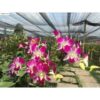# Monthly Care Guide for Dendrobium Orchids

Dendrobium orchids are renowned for their stunning flowers, diverse species, and relatively easy care requirements compared to other orchid types. However, successful Dendrobium cultivation requires a well-planned monthly care schedule to ensure these beautiful plants thrive. This guide will provide a comprehensive month-by-month plan for caring for your Dendrobium orchids, addressing watering, fertilization, light requirements, temperature, humidity, and repotting.
## January: Assessing Dormancy and Preparing for New Growth
### Care Tasks:
– **Check Light Conditions**: Ensure your Dendrobium is receiving adequate light, as winter days can be shorter and dimmer. Position them near a south or west-facing window for optimal light.
– **Watering**: Reduce watering frequency as the orchid is likely in its dormant phase. Water only when the top inch of the potting medium feels dry, typically every 2-3 weeks.
– **Temperature and Humidity**: Maintain indoor temperatures between 60°F to 70°F (15°C to 21°C) during the day and slightly cooler at night. Keep humidity levels around 40-50%.
### Fertilization:
– Avoid fertilizing during dormancy. Instead, focus on maintaining proper moisture levels in the potting medium.
## February: Preparing for New Growth
### Care Tasks:
– **Light and Positioning**: Continue to ensure your Dendrobium receives enough light, adjusting its position if necessary.
– **Watering**: Gradually increase watering as temperatures begin to warm up. Water every 2 weeks or when the medium dries out.
– **Temperature**: As winter transitions to spring, slightly increase daytime temperatures, aiming for 70°F to 75°F (21°C to 24°C).
### Fertilization:
– Start fertilizing with a balanced orchid fertilizer (30-10-10) at half-strength every 4 weeks. This supports new growth.
## March: New Growth Emerges
### Care Tasks:
– **Light**: Ensure bright, indirect sunlight for new growth. Consider rotating the orchid to promote even growth.
– **Watering**: Water more frequently, about every 1-2 weeks, as the plant begins active growth.
– **Humidity**: Maintain humidity levels around 50-60%, as new growth benefits from higher humidity.
### Fertilization:
– Continue with the balanced fertilizer every 4 weeks, adjusting to a higher nitrogen formula to support leaf development.
## April: Flowering Time Approaches
### Care Tasks:
– **Light**: Provide bright light to encourage flowering. If outdoors, ensure protection from direct afternoon sunlight.
– **Watering**: Water regularly, about once a week, ensuring proper drainage.
– **Temperature and Humidity**: Keep temperatures between 70°F and 80°F (21°C to 27°C) during the day.
### Fertilization:
– Switch to a bloom-boosting fertilizer (20-20-20) to promote flowering. Apply every 4 weeks.
## May: Peak Blooming Season
### Care Tasks:
– **Light**: Provide full bright light to support blooming. Consider moving the plant to a location with filtered sunlight.
– **Watering**: Increase watering frequency to once a week, allowing the potting medium to dry slightly between waterings.
– **Humidity**: Maintain humidity at around 60-70% to support blooming.
### Fertilization:
– Continue using the bloom-boosting fertilizer every 4 weeks. You may also foliar feed with a diluted solution for immediate nutrient uptake.
## June: Post-Bloom Care
### Care Tasks:
– **Light**: After blooming, continue providing bright, indirect light. Some direct sunlight can be beneficial.
– **Watering**: Maintain the watering schedule, about once a week, as new growth continues.
– **Temperature**: Aim for temperatures around 75°F to 85°F (24°C to 29°C).
### Fertilization:
– Switch back to a balanced fertilizer (30-10-10) every 4 weeks to support vegetative growth.
## July: Active Growth Phase
### Care Tasks:
– **Light**: Ensure your Dendrobium receives sufficient light as it enters an active growth phase.
– **Watering**: Continue watering weekly, checking the medium for moisture.
– **Humidity and Airflow**: Keep humidity levels high, ideally above 60%. Good airflow is essential to prevent fungal issues.
### Fertilization:
– Continue fertilizing every 4 weeks with a balanced fertilizer.
## August: Continued Growth and Preparation for Dormancy
### Care Tasks:
– **Light**: Provide bright light for healthy growth.
– **Watering**: Maintain a consistent watering schedule, approximately once a week.
– **Temperature**: Ensure temperatures remain warm, ideally between 75°F and 85°F (24°C to 29°C).
### Fertilization:
– Keep feeding every 4 weeks. As growth slows, consider reducing the fertilizer concentration.
## September: Transitioning to Dormancy
### Care Tasks:
– **Light**: Gradually reduce light exposure as days shorten.
– **Watering**: Begin to taper watering frequency, allowing the potting medium to dry out more between waterings.
– **Temperature**: Maintain temperatures around 70°F (21°C) during the day.
### Fertilization:
– Reduce or stop fertilizing as the plant prepares for dormancy.
## October: Entering Dormancy
### Care Tasks:
– **Light**: Ensure adequate light, but reduce exposure to harsh afternoon sun.
– **Watering**: Water less frequently, about every 2-3 weeks.
– **Humidity**: Keep humidity levels steady, around 40-50%.
### Fertilization:
– No fertilization is needed during dormancy.
## November: Maintaining Dormancy
### Care Tasks:
– **Light**: Continue to provide bright, indirect light.
– **Watering**: Maintain the watering schedule, checking for dryness before watering.
– **Temperature**: Keep indoor temperatures consistent, avoiding cold drafts.
### Fertilization:
– No fertilization required as the plant remains dormant.
## December: Preparation for New Growth
### Care Tasks:
– **Light**: Check light levels and adjust positioning if needed for the upcoming growth phase.
– **Watering**: Continue with minimal watering, allowing the plant to remain dry between waterings.
– **Temperature**: Ensure the orchid is kept in a warm, stable environment.
### Fertilization:
– Avoid fertilization. Focus on maintaining ideal conditions for dormancy.
## Additional Care Tips Throughout the Year
### Watering Techniques
– Always use room-temperature water to avoid shocking the plant.
– Water in the morning to allow excess moisture to evaporate throughout the day, reducing the risk of rot.
– Consider using a moisture meter to check the moisture levels of the potting medium.
### Potting Medium and Repotting
– Dendrobium orchids thrive in well-draining potting media. A mix of bark, perlite, and sphagnum moss is ideal.
– Repotting should typically be done every 1-2 years or when the potting medium breaks down. The best time to repot is after flowering, ideally in the spring.
### Pest and Disease Management
– Regularly inspect your orchids for signs of pests like aphids, mealybugs, and spider mites. Use insecticidal soap or neem oil for treatment.
– Ensure good air circulation around your plants to prevent fungal infections.
### Light Requirements
– Dendrobium orchids prefer bright, indirect light. If natural light is insufficient, consider using grow lights for 12-14 hours daily, especially during the winter months.
### Humidity and Temperature
– To maintain humidity, consider using humidity trays or room humidifiers. Aim for a humidity level of 40-70%, depending on the growth stage.
– Avoid placing orchids near heat sources, air conditioners, or drafty windows to ensure consistent temperatures.
## Conclusion
Caring for Dendrobium orchids throughout the year requires attention to detail and a consistent care routine. By following this monthly care guide, you can create an ideal environment for your Dendrobium orchids to thrive. With patience and dedication, you’ll be rewarded with beautiful blooms and lush foliage, making your efforts worthwhile. Whether you’re a seasoned orchid enthusiast or a beginner, proper planning and care will ensure your Dendrobium orchids flourish, bringing joy and beauty to your home.

